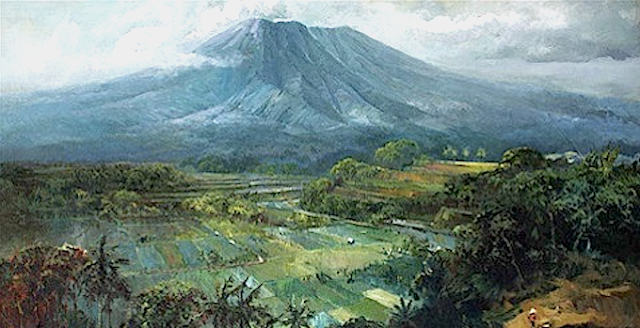ALEXANDER VON HUMBOLDT (1769-1859),
Cofre de Perote/ Naupa-Tecutépetl (4,282 m (14,049 ft)
Mexico
The mountain
Cofre de Perote, also known by its Nahuatl names Naupa-Tecutépetl , meaning something like "Place of Four Mountain" or "Mountain of the Lord of Four Places",
is an inactive volcano located in the Mexican state of Veracruz, at the
point where the Trans-Mexican Volcanic Belt, home to all of Mexico's
highest peaks, joins the Sierra Madre Oriental. Cofre de Perote is
Mexico's eighth highest mountain summit.
Cofre de Perote is a shield
volcano, shaped very differently from the stratovolcanic Pico de
Orizaba, which lies about 50 km (31 mi) to the southeast. A cofre is a
coffer, and the name alludes to a volcanic outcropping on the shield
which constitutes the peak of the mountain. To the north is the town of
Perote, Veracruz, after which the mountain is named. The area
surrounding the volcano was protected by the Mexican government as a
national park, known as Cofre de Perote National Park (Parque Nacional
Cofre de Perote), in 1937.
The artist
Friedrich Wilhelm Heinrich Alexander von Humboldt was a Prussian geographer, naturalist, explorer, and influential proponent of Romantic philosophy and science. He was the younger brother of the Prussian minister, philosopher, and linguist Wilhelm von Humboldt (1767–1835). Humboldt's quantitative work on botanical geography laid the foundation for the field of biogeography. Humboldt's advocacy of long-term systematic geophysical measurement laid the foundation for modern geomagnetic and meteorological monitoring.
Between 1799 and 1804, Humboldt travelled extensively in Latin America, exploring and describing it for the first time from a modern scientific point of view. His description of the journey was written up and published in an enormous set of volumes over 21 years. Humboldt was one of the first people to propose that the lands bordering the Atlantic Ocean were once joined (South America and Africa in particular). Humboldt resurrected the use of the word cosmos from the ancient Greek and assigned it to his multi-volume treatise, Kosmos, in which he sought to unify diverse branches of scientific knowledge and culture. This important work also motivated a holistic perception of the universe as one interacting entity.
On their way back to Europe from Mexico on their way to the United States, Humboldt and his fellow scientist Aimé Bonpland stopped in Cuba for a while. After their first stay in Cuba of three months they returned the mainland at Cartagena de Indias (now in Colombia), a major center of trade in northern South America. Ascending the swollen stream of the Magdalena River to Honda and arrived in Bogotá on July 6, 1801 where they met Spanish botanist José Celestino Mutis, the head of the Royal Botanical Expedition to New Granada, staying there until September 8, 1801. Mutis was generous with his time and gave Humboldt access to the huge pictorial record he had compiled since 1783. Humboldt had hopes of connecting with the French sailing expedition of Baudin, now finally underway, so Bonpland and Humboldt hurried to Ecuador. They crossed the frozen ridges of the Cordillera Real, they reached Quito on 6 January 1802, after a tedious and difficult journey.
Their stay in Ecuador was marked by the ascent of Pichincha and their climb of Chimborazo, where Humboldt and his party reached an altitude of 19,286 feet (5,878 m). This was a world record at the time, but a thousand feet short of the summit. Humboldt's journey concluded with an expedition to the sources of the Amazon en route for Lima, Peru.
At Callao, the main port for Peru, Humboldt observed the transit of Mercury. On 9 November and studied the fertilizing properties of guano, rich in nitrogen, the subsequent introduction of which into Europe was due mainly to his writings.
___________________________________________
2021 - Wandering Vertexes...
by Francis Rousseau
















